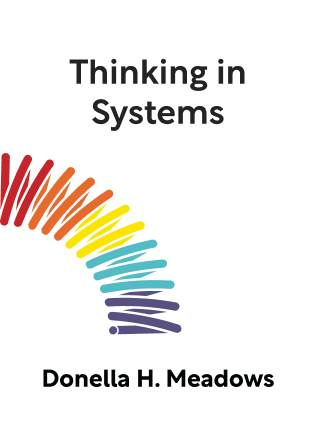

This article is an excerpt from the Shortform summary of "Thinking in Systems" by Donella H. Meadows. Shortform has the world's best summaries of books you should be reading.
Like this article? Sign up for a free trial here .
What is the system thinking meaning? How does it work?
The system is something that is made up of interdependent and interconnected parts that work as one. The system thinking meaning is the ability to be able to look at all things as a system to improve how they work.
Read more about the system thinking meaning below.
System Thinking Meaning: Seeing Things as Systems
What is a system? A system is 1) a group of things that 2) interact to 3) produce a pattern of behavior.
Many things in the world operate as systems.
- The human liver is a group of cells that interact to detoxify the blood, among other functions. The liver is, in turn, part of the larger system of the human body.
- A football team consists of a group of players on the field, each with a specific role that interacts with the others. The team also consists of coaches, support staff, and fans.
- Within the system of a corporation, people, machines, and information work together to achieve the corporation’s goals. This corporation then takes place within the larger system of the economy.
Systems may look different on the surface, but if they have the same underlying structure, they tend to behave similarly.
- For example, consider the simple system of a bathtub. There is a spout that adds water to the system, and a drain that removes water from the system. If the spout adds water faster than it drains, the bathtub will fill and the water level will rise. Conversely, if the drain removes water faster than the spout adds water, the bathtub will empty.
- Now consider the system of the world population. From a system point of view, it looks similar to the bathtub. The birth rate adds people to the population; death removes people from the population. If the birth rate exceeds the mortality rate, the population will rise. If people die faster than they are born, the population will fall.
In reality, if you look deeper, the world population is a much more complex system—it’s subject to the economy, health science, and politics, each of which is its own complicated system. But from a certain simplified vantage point, the bathtub and the world population behave similarly.
Understanding the underlying system and how it behaves may be the best way to change the system.
Cause and Effect Isn’t Enough
When we try to explain events in the world, we tend to look for simple cause and effect relationships.
- An oil company is blamed for greedily driving up the price of oil.
- When you get sick, you blame the cold virus for attacking your body.
- Drug addiction is blamed on the weak fortitude of the people addicted to drugs.
This simplicity is reassuring in some ways. Turn this knob, and you solve the problem—easy. In turn, it becomes easy to blame people who do not turn the knob the way you want it to be turned.
However, in the true system thinking meaning, reality tends to be more complex than simple cause and effect relationships, because they are a product of complicated systems. Systems consist of a large set of components and relationships; a system’s behavior is not the result of a single outside force, but rather the result of how the system is set up.
- The oil company’s actions could not cause global oil prices to rise, if the system didn’t allow it to exert this control. This relates to how readily people consume oil, the lack of viable energy alternatives to oil, and national pricing policies. All these system properties make economies vulnerable to oil suppliers.
- A flu virus could not make you sick if your body did not create the conditions that allowed it to thrive. The virus is not attacking you—it is interacting with the system of your body.
- Drug addicts participate in a system that includes drug sellers who want to make money; governments that make drugs illegal and enforce laws with police; nonaddicts who influence how society balances punishing criminals versus rehabilitating them.
When viewed from this system lens, causing change is much more difficult than applying a single cause and expecting an effect. It requires an upheaval of the system itself, with all its components and connections.
- You cannot neutralize an oil company’s power over an economy without also changing how people and companies consume oil and the availability of viable alternatives to oil.
- You cannot eradicate drug addiction without also changing the laws around drugs, the economic incentives for drug distribution, and the mindset of the voting public.
Without understanding the system that produces a problem, you cannot design effective solutions that solve the problem. Indeed, many “solutions” have worsened the problem because they ignored how the system was set up.
Learn about to be a systems thinker and about the meaning of system thinking.
- First, you’ll learn the definition of a system and how a system is set up.
- Then, you’ll see the “systems zoo”—a variety of examples of systems and how they behave.
- Finally, you’ll learn why systems often behave unexpectedly and common problems in changing systems.
As a systems thinker, you’ll begin to see systems everywhere, and you’ll look at the world in a new way. In so doing, you’ll be more effective at restructuring systems to achieve the outcome you want.
What Are Systems?
A system is composed of three things according to the system thinking meaning:
- Elements: The individual things in the system
- Interconnections: The relationships between the elements
- Purpose or Function: What the system achieves
To define it more cohesively, a system is a set of elements that is interconnected in a way that achieves its function.
Many things in ordinary life are systems. Let’s define how a professional football team is a system using the meaning of system thinking:
- Elements: The players, the coaches, the field of play, the ball
- Interconnections: The rules of football, the way players in specific roles interact with each other, how the coaches instruct the players, how the laws of physics govern how the ball moves
- Purpose: To win football games, to have fun, to make money
As you look around the world, you’ll see systems everywhere. So what is not a system? A set of elements that are not interconnected in a meaningful way or overall function is not a system. For example, a pile of gravel that happens to be on a road is not a system—it’s not interconnected with other elements and does not serve a discernible purpose.
In this chapter, we’ll dive deeper into understanding the three attributes of a system. We’ll then understand how systems behave over time, and how the interconnections can drive system behavior.
(Shortform note: in this chapter we’ll develop an extended example of a football team beyond what’s contained in the book, but in a way that’s consistent with its ideas. You should actively apply the ideas to develop your own examples of systems, such as a corporation, a university, a tree, or the government.)
System Thinking Meaning: How Systems Relate to Each Other
Because you can now see systems everywhere you look, you might have seen that systems can be composed of other systems, and so on in a fractal-like pattern.
For example in the system thinking meaning:
- Each player on a football team is himself a complex system, consisting of his organ systems, his thinking, his own motivations.
- The multiple players together form a system of the playing team on the field.
- The players with the coaching staff form an overall system at a team level.
- The team combines with its fans and the overall city to form another system.
- The team combines with the other teams in the sport to form another system at the league level.
- The league combines with the other sports leagues in the world to form another system.
The systems can thus get quite complex according to the meaning of system thinking.
The individual subsystems may have conflicting purposes from the overall system purpose, which can lower function of the system. For example, if the individual players on a football team care more about their personal reputation than the success of the team, the overall team system will perform poorly. For a system to function effectively, its subsystems must work in harmony with the overall system.

———End of Preview———
Like what you just read? Read the rest of the world's best summary of Donella H. Meadows's "Thinking in Systems" at Shortform .
Here's what you'll find in our full Thinking in Systems summary :
- How the world, from bathtub faucets to fish populations, can be seen as simple systems
- The key system traps that hold back progress, such as escalating arms races and policy addiction
- Why seeing the world as systems can give you superpowers in work and life






